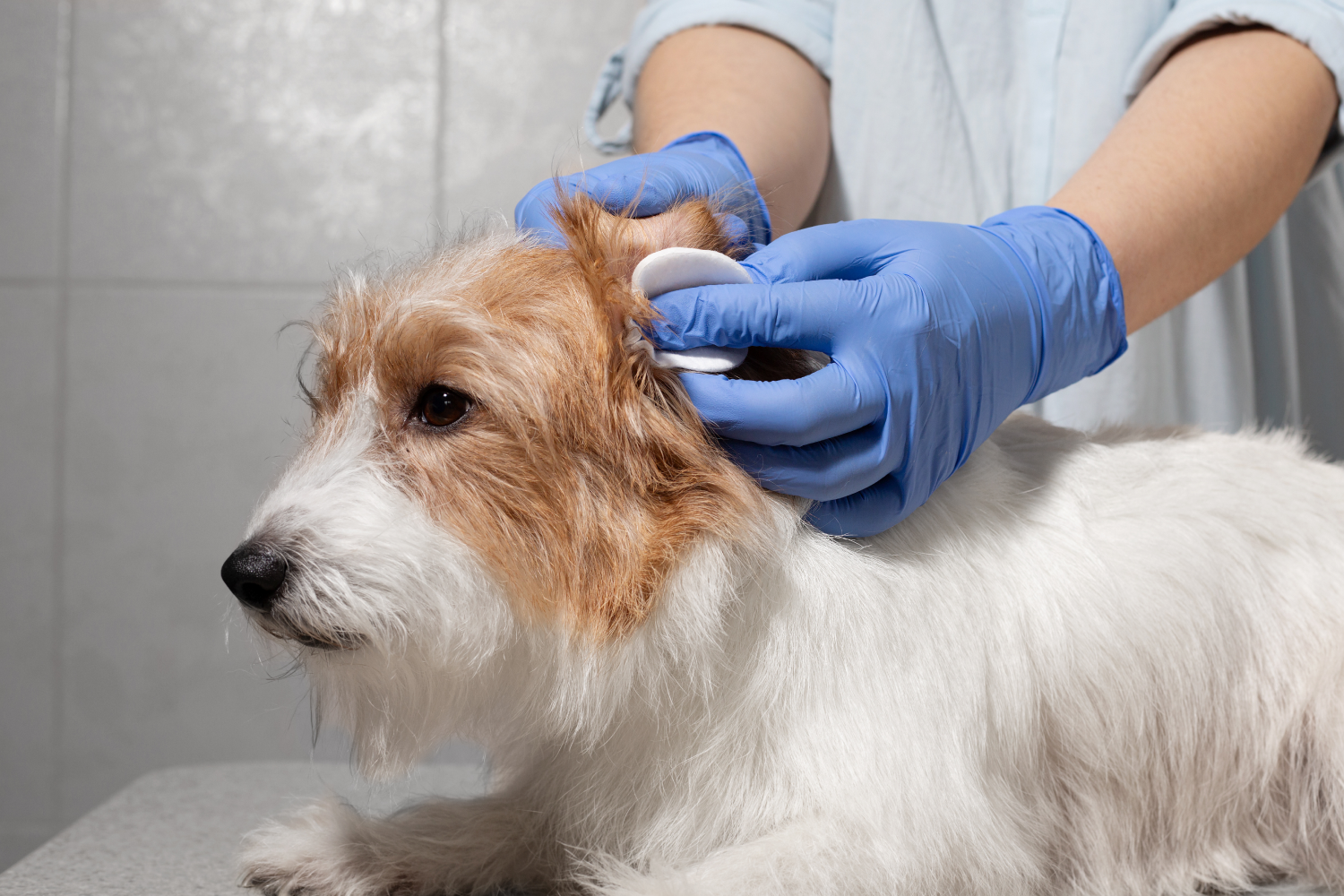
BOGO: buy a box of Longevity15 and get Yummy Combs free!
Shop now and get the BOGO deal today!
Joseph Roetheli, PhD

Highlights:
Cleaning your dog’s ears is an essential part of their care, but it’s important to know how to do it correctly to avoid injuring them.
Taking care of your dog’s ears can help reduce their risk of ear infections but overcleaning can lead to irritation.
Alongside ear cleaning, it’s important to consider your dog’s longevity. Adding Longevity15 to their diet can make a big difference.
Your dog’s ears might be straight and pointy or long and floppy. They love to have them scratched, but they also need to have them cleaned as part of their regular grooming.
If your dog gets professional grooming, the groomer is likely cleaning your dog’s ears. If not, it’s up to you as your dog’s primary caregiver to take care of your dog’s ear cleaning needs at home.
Some dogs will need ear cleaning more frequently than others. Dogs who have particularly long ears (think Basset hounds or Cocker Spaniels) will need their ears cleaned more frequently because they are at higher risk of developing ear infections.
Together, we’ll talk about how to tell when your dog’s ears need cleaning, what you need to clean them, and how to do it. We’ll also talk about a tasty treat to offer your dog after the ear-cleaning process is complete.
Before you can clean your dog’s ears, it is important to learn how to tell the difference between ears that need cleaning and ears that don’t. Most dog ears should appear pink in color, not red or inflamed.
Dogs’ ears should also be odorless. If you notice red inflammation accompanied by head-shaking and a foul odor, your dog may have an ear infection. A discharge of any kind from the ear may also indicate an infection.
Never clean your dog’s ears if you suspect they might have an ear infection. Instead, take them to their veterinarian and follow their instructions for any medication or cleansing. Once your dog is free from infection, you can clean your dog’s ears safely at home when they smell a little yucky or have visible signs of buildup (ear wax) in the outer ear flap or ear canal.
Before you begin, you’ll need a few supplies to get the job done correctly. You can find a dog-safe ear-cleaning solution at your dog’s veterinarian’s office or a local pet store.
Even though you can likely find a few DIY dog ear-cleaning solution formulas online, getting the formula right can be tricky, and if you are not careful, you could add an ingredient that could irritate your dog’s delicate ear skin.
In addition to a good ear cleaner, you’ll simply need a cotton ball or gauze and a towel for drying the ear area when you are done cleaning. As tempting as it may be to grab a few Q-tips, avoid using cotton swabs because they can push dirt further into your dog’s ear canal.
Additionally, it’s easy to go further into the ear is safe when using a cotton swab. With a cotton round or cotton ball, you’ll be able to stay in the safe zone.
If your dog has never had their ears cleaned, it’s unlikely they are going to love the process the first time. Before you attempt to clean your dog’s ears, start by scratching and touching the ears to get them accustomed to having the ears touched.
If your dog seems sensitive to touch or winces, they may have an ear infection, ear mites, or other issue that needs to be inspected by their veterinarian. Once your dog is ready for ear-cleaning, move them to an area that is safe and calm, like the bathroom floor or a quiet room.
In addition to ear cleanser, cotton, and a towel, consider a few treats, a favorite chew toy, or a licking mat to keep your dog distracted while you work and make regular cleaning a positive experience for your dog.
Using the veterinarian-approved ear cleanser, squeeze a small amount into the base of your dog’s ear canal. The bottle should give you instructions on how much to use, but a pea-sized amount is all that is needed to effectively clean the ears. Be sure to thoroughly clean the tip of the applicator so that it does not become contaminated with bacteria from your dog’s ear.
Next, massage the solution into your dog’s ears for about 30 seconds. To do this, massage the base of the ear (just under the opening). If your dog has floppy ears, flop the ears over the opening and massage through the ear flaps. You’ll hear the solution squishing around, which means it is breaking down the buildup in the ear and removing dirt and debris.
Pro tip: If you have trouble counting seconds, consider singing the happy birthday song to measure the length of time necessary to get a good clean, similar to washing your hands.
Once you’ve completed Fido’s massage, let your dog shake their head with gusto. This is one time when it’s okay for them to shake and scratch, as it helps to remove debris and excess solution without rubbing or wiping their sensitive ears.
Once the shakedown is complete, use a cotton ball or gauze to gently clean out the ear canal. You shouldn’t ever attempt to insert anything, including your finger, into your dog’s ear, and never go further into your dog’s ear than your first knuckle.
Using the towel, dry off your dog’s ears and ensure the fur surrounding the ear is completely dry. If you leave the ear area damp, you risk a yeast infection inside the ear that can become itchy and smelly very quickly.
Pro tip: Airflow is your partner on ear cleaning day. After you’ve cleaned your dog’s ears, take them outside and allow them to run around to get air flowing into the ears and keep the area dry.
To avoid the possibility of harming your dog’s eardrum or possibly giving them another unintended ear problem, be sure to avoid these common ear-cleaning mistakes.
Dog ear infections can be problematic for some dog breeds. If your dog is getting recurrent ear infections, stop cleaning your dog’s ears and take them to the vet for an inspection and instructions on how to care for your dog’s ears in the future.
Longevity15 is the first and only supplement available for dogs with pentadecanoic acid or C15:0. C15:0 is an odd-chain, saturated fatty acid that is the first essential fatty acid to have been discovered since the omegas over 90 years ago.
C15:0 supports your dog’s heart health and liver function by targeting the foundation of your dog’s health: their cells. C15:0 deep dives into cells to keep them supported, which helps support your dog’s entire body.
C15:0:
The C15:0 in Longevity15 helps support your dog’s overwell wellness and is one of the smartest moves you can make to help your dog live a longer life. Best of all, it comes free of side effects and won’t ever give them any fishy breath. That means fresher breath and more close cuddles.
Cleaning your dog’s ears is an integral part of being a dog owner. You’ll keep your dog’s ears healthy if you routinely inspect and clean their ears. If your dog initially hates the process, don’t worry. Offering incentives, like treats, can help your dog trust ear cleaning and look forward to it.
And don’t forget to add in supplements to support a long and healthy life, like Longevity15.
Sources:
How to Clean a Dog’s Ears | American Kennel Club
Ear Cleaning and Administering Ear Medication in Dogs | VCA | VCA Animal Hospitals
Relation between periodontal disease and systemic diseases in dogs | ScienceDirect
Updates, coupons, deals, and more!
Type anything...
We use cookies to provide you the best possible experience on our website. You consent to the usage of cookies by continuing to view our website. See our Privacy Notice for more information.